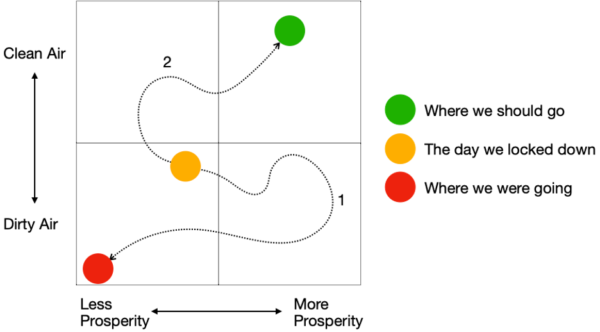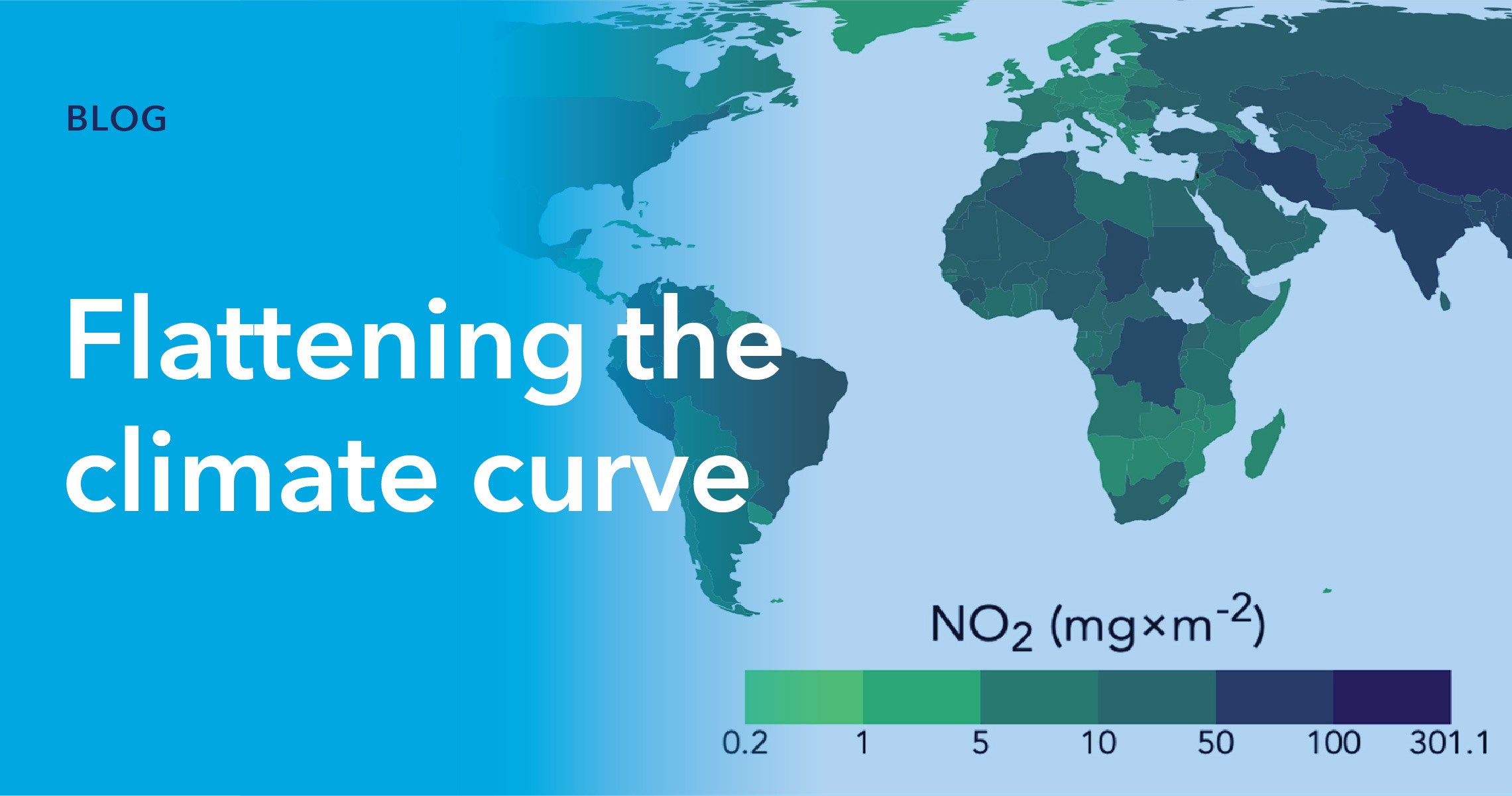We must admit with humility that,
While number is purely a product of our minds, space has a reality outside our minds,
So that we cannot completely prescribe its properties a priori
—Gauss
“Flattening the Curve” has become a rallying cry of public health officials fighting Covid-19 around the world. By now, almost everyone has heard the phrase and understood the rationale behind social distancing policies: if we stay away from each other, 1 may not become 2, 2 won’t become 4 and so forth. This logic is necessary to prevent our healthcare systems from becoming overwhelmed.
A salutary side-effect of flattening the curve is that billions have gained a free education in the dynamics of a college engineering mathematics exercise—one can change the outcome of an experiment by changing behavior. Thanks to Covid-19 and the generally positive actions taken by governments and citizens alike, flattening the curve is now a reality that we are all living. This is an important lesson for another curve-flattening exercise that is required of us—bending our emissions curve. The Keeling Curve—the curve representing the concentration of carbon dioxide in Earth’s atmosphere—has been steadily increasing since records began. Discounting seasonal variation, Keeling shows average annual atmospheric CO2 increasing from about 315 ppm to nearly 414 ppm between 1958 and 2020 in an alarming upward slope.
As the climate goes out of kilter and into chaos, the crisis is going to be far worse than what we are seeing with Covid-19. We are not going to be able to “shelter in place” as there won’t be any shelter. While the existential threat posed by climate change is far worse than with unchecked Covid-19 (there is no herd immunity when the oceans rise), our will to rationalize denial causes us to ignore the inevitability of impending climatic catastrophe. The Keeling Curve plays out like the story of the boiling frog, who thinks it is having a warm bath until the water starts to boil; the endpoint builds slowly, accelerates, and ends soon in a horrible outcome.
Decisive action on climate change has consistently been thwarted by psychological distancing. It’s someone else’s problem, some other country’s problem, some problem that is far off in the future. 2020 has seemingly shot through these psychological barriers as portentous scenes of the Australian wildfires, Greta Thunberg’s determined gaze, and disastrous floods boomed through the technological microphone of social media and wrenched us somewhat from our complacency. However, our psychological defenses precluding action also stem from the overwhelming complexity of the climate crisis. We live in an intractable and vastly complicated mesh of carbon-dependent systems that are in increasing danger. Climate equations are far more dynamic than a simple two dimensional bell curve that we can conveniently squish down by staying at home and watching Netflix. This is in part due to a series of climate ‘tipping points’—thresholds that, when crossed, push Earth’s systems towards rapid and irreversible change.
The Covid-19 pandemic and the resultant economic slow-down has given us a unique view into what happens if we stopped emissions on a grand scale. The 2019 Intergovernmental Science Policy Platform on Biodiversity and Ecosystem Services report warned that 75% of our terrestrial environment has been “severely altered” by human actions. Economic activity and population growth has pushed through Earth’s ecological ceiling with dramatic effects. Climate, ocean, soil, biodiversity, freshwater, and ozone systems have maxed out. But, as we have taken our foot off the economic pedal, our environment has seen a marked change. Skies are clear and nature has re-emerged. We have before us an opportunity to derive a baseline as a function of reduced industrial activities that can be used as a high-water mark for our environment for when we turn things back on.
In order to capture this baseline marker, Intertrust built Planet OS View2020. The idea is simple: a window into a series of measurements of environmental parameters from a variety of reputable sources on classic parameters like air pollutants and ozone to determine a baseline. Going one step further, Planet OS View2020 invites everyone from scientists to government agencies to bird watchers to contribute data that we will curate and make available through our service. Using Planet OS’s advanced data rights management capabilities, we can manage interests associated with these data, allowing people with diverse datasets to share and create a force multiplier, while protecting interests, making visualizations available that show correlations and variance over time. Our plan is to track data including pollutants, ocean temperature, bioacoustics, and ecology in order to follow deviations from this 2019 baseline marker throughout 2020 and beyond.
Ultimately, this indicator can be used not only to measure progress (or regress) but also to create tracking metrics that go well beyond carbon credits. We invite environmental scientists and economists to collaborate on defining these factors. We can expose the right data, make it shareable, and run a neutral medium for the measurements to take place. Our hope is that the platform can be used for open research and reporting and eventually connect to real time sensors, promoting sharing and data exchange.
When we eventually emerge from our Covid-19 lockdowns and turn our economies back on—as certainly we shall, and certainly we will—the urge to turn everything back on at full bore will be real. Our hope is that we can regain economic prosperity in a way that maintains the climate. While some may argue that the two are irreconcilable, we believe that there may be a happy medium, under which we can have climate positive economic prosperity—where economic and climate metrics are optimized together. Our hope is that the View2020 baseline developed through this time can be used as a high watermark for how we measure progress going forward.

Corporations have a crucial role to play in helping us move from yellow to green in the illustration, as they can control how they drive towards more growth. The current economic crisis and the ensuing recovery, with generous economic assistance from governments, will provide all sorts of opportunities to reinvent operations in a more constructive way. Doing so in a manner that factors in improved climate hygiene is not only serving a moral purpose but potentially preserving future opportunities for growth.
Technology companies can go one step further by providing tools for citizens, business leaders, and governments to use not only to track adherence to the new baseline, but also to provide feedback loops that help guide behavior. This goes beyond good citizenship to possibly fueling the next startup boom around innovations that steer us towards the upper quadrant of the illustration. Technology companies are well endowed with both financial and intellectual resources that create tools such as data infrastructure, sensor technology, data platforms, and cloud computing resources. These tools are necessary for people to understand the complex natural world. They are also necessary for tracking progress towards national and international environmental goals. For the last decade, we have relied on an awkward dance of agreements between governments and grassroots activism. It is time to let free market forces join the dance to drive affirmative climate action with profit as a driver.
Microsoft’s recent announcement of a Planetary Computer, building on their AI for Earth program, is indicative of the stronger push from technology companies to mobilize their resources for environmental good. Recent displays of cooperation between rivals like Apple and Google to create a Covid-19 tracking software show the degree to which companies can work together to solve problems during crises.
Crucially, technology will not solve our environmental issues. While increasing efficiency due to technology can lead to a win-win situation, to date, it has mostly led to an increase in consumption and demand over time, thereby heightening the strain on our environment—Jevon’s Paradox. “Solving” for environmental issues requires a more fundamental reorientation of our relationship to the natural world. Technology’s biggest challenge will be to upload this reorientation into our collective consciousness. Meanwhile, technology can provide the tools for helping humanity understand and track the complexity of it all. Boiling down an ocean of anxiety, incoherence, and unfamiliarity into the universal language of numbers.
For more information please contact our sales team.

